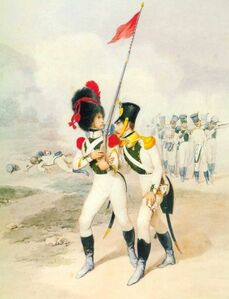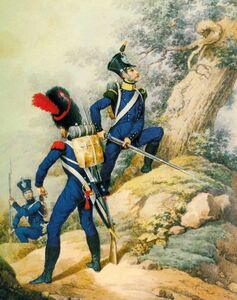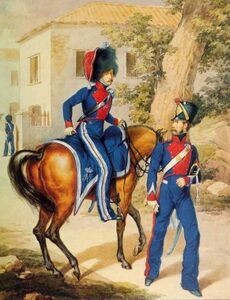Regiments
Neapolitan Regiments
The Reggimento (regiment) was the primary unit of organisation for large bodies of Neapolitan soldiers.
Neapolitan regiments usually consisted of 1,000-3,000 soldiers organised into battalions or squadrons, which were the basic organisational units of men used by commanders in battle.
I'm Interested In |
|
|
| |
|
Organised along French lines, Neapolitan regiments usually consisted of 1,000-3,000 soldiers organised into battalions or squadrons, which were the basic units of men used by commanders in battle.
Regiments were typically recruited by region or province, although with the loss of personnel, units had to frequently be replenished to full strength with whatever manpower was available, regardless of their origin. Regiments were typically commanded by a Colonel. At its peak size in 1815, the Neapolitan Army had a total (on paper) strength of 94,463 men split into 35 regiments, the average Line Regiment having three battalions split into twenty-one companies, and one depot battalion of three companies. By decree of 3rd December 1812, each light and line infantry regiment was raised to four battalions, hence giving each regiment a total active strength of 3,360 men (excluding the depot). The term Reggimento had already been used in Southern Italy since the 17th Century when the tercios previously used by the Kingdom’s Spanish rulers were abandoned in favour of French-styled units from the Bourbon monarchy.
This developed during Charles I’s reign in the 18th Century, and by the French Revolutionary Wars, the Neapolitan Bourbon Army was constituted by some 30 or so regiments. | |
| |
|
As stated in the above-named decrees, every Neapolitan regiment was organised “in the same way, with the same pay, as the French regiments of the same arm”. In 1806, each infantry battalion consisted of 9 companies, split into 7 companies of Fusiliers (fucilieri), 1 company of Grenadiers (granatieri), and 1 of Voltigeurs (volteggiatori). In Light Infantry regiments, the former two were known as Chasseurs (cacciatori) and Carabiniers (carabinieri) respectively. In 1808, by Napoleon’s decree of 18th February, the regimental organisation was augmented: each battalion was reduced to six (stronger) companies of 140 men each, the fusiliers now numbering 4 companies and the rest keeping their previous establishments. This was introduced into the Neapolitan Army as well as within the armies of all French-aligned client states in 1808 and onwards. Fusiliers or Chasseurs were the main rank-and-file of the regiment, forming around 80% of its total strength. They constituted the hardened core of each unit, and all new recruits from the depot were transferred to serve as them. Only later in their careers would they be allowed to transfer to one of the élite companies, having met the necessary requirements. As basic fusiliers or chasseurs, they experienced much less prestige and privileges than their counterparts within the grenadier and voltigeur companies, although their performance was of paramount importance to the outcome of battles. Grenadiers or Carabiniers were the flower of the regiment’s soldiers; tall, skilled, and experienced, these veterans formed each battalion’s elite reserve. A minimum height of 173.5cm and 2-4 years of exemplary service were required to be accepted into the grenadier company. While not actually equipped with grenades, they would wear bearskins and “flaming grenade” insignia on their uniforms to show their status; apparently, the expensive headgear was kept on even in the trying conditions of the Russian campaign, in contrast to their French counterparts (who had discarded the use of bearskins in line regiments earlier that year). In battle, grenadiers took part in the heaviest fighting. They were deployed to storm fortifications, take villages, form the front of attack columns, and take “any post that was dangerous and therefore honourable”. At times, grenadier companies from different battalions were grouped together to form entire battalions or even regiments; a notable example of this was Macdonald’s provisional regiment in the 1813 campaign. Finally, the fastest and best shots of the battalion were grouped into the Voltigeur company. As the second élite company, they also wore uniforms with epaulettes and plumes (painted green and yellow). The maximum height for voltigeurs was 150cm, with officers being allowed an inch more. As suggested by their name (French for literally “vaulters”), men within the voltigeurs had to be nimble enough to spend the battle energetically harassing and pursuing the enemy. On almost all occasions Neapolitan voltigeurs fought in open order, and rarely in line or in column. Their duty was to screen their comrades deployed in line, to provide covering fire, and to counter enemy skirmishers. As a whole, Neapolitan voltigeurs performed well, although they were more susceptible to desertion due to the freedom of movement given to them. |


